Recruiting costs are not cheap. According to 2022 benchmarking data from the Society for Human Resource Management (SHRM), the average cost per hire was nearly $4,700.
To reduce recruitment costs effectively, businesses need to look beyond the obvious. While many track expenses like job board fees and recruiter salaries, there’s a much larger iceberg of hidden costs beneath the surface. Time spent by hiring managers reviewing resumes, lost productivity from prolonged vacancies, and the high cost of bad hires all quietly add up in the background.
In this comprehensive guide, we’ll peel back the layers to reveal what truly drives recruitment costs and arm businesses with actionable strategies to reduce recruitment costs at every stage of the hiring process.
Let’s start.
Exploring the Recruitment Costs
Before finding ways to reduce recruitment costs, businesses first need a clear understanding of what drives those costs and how to measure them properly.
What is recruitment cost?
According to the International Labour Organization, the terms “recruitment costs” or “related costs” refer to any fees or expenses incurred during the recruitment process in order for workers to secure employment or placement, regardless of the manner, timing, or location of their imposition or collection.
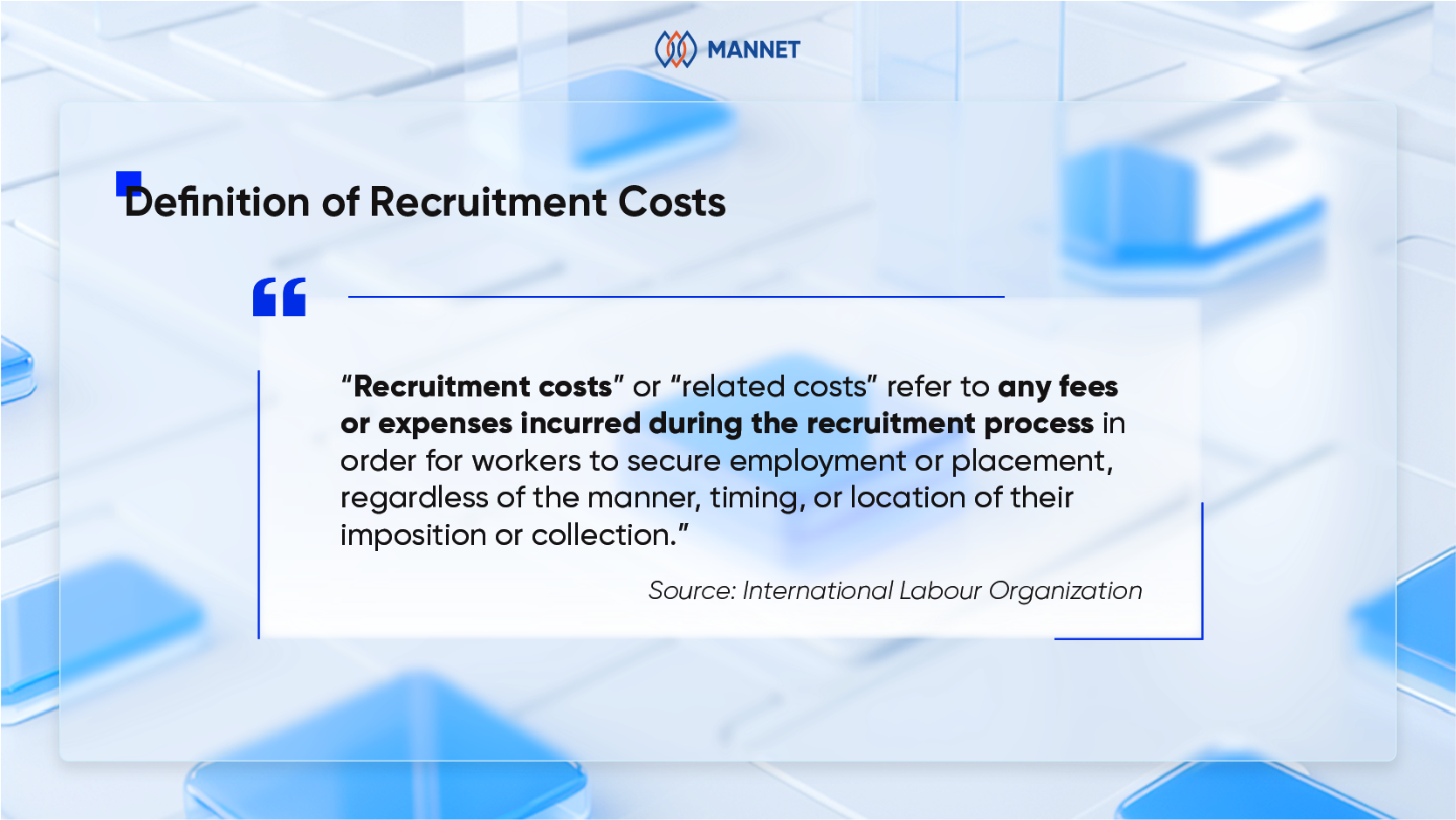
What is recruitment cost?
While every company may have its own approach to hiring, most businesses tend to face similar types of expenses along the way. We’ll take a closer look at these typical costs in the next section.
How to calculate recruitment costs?
Most organizations incur both internal and external costs throughout the hiring process, and together, these make up the total recruitment costs.
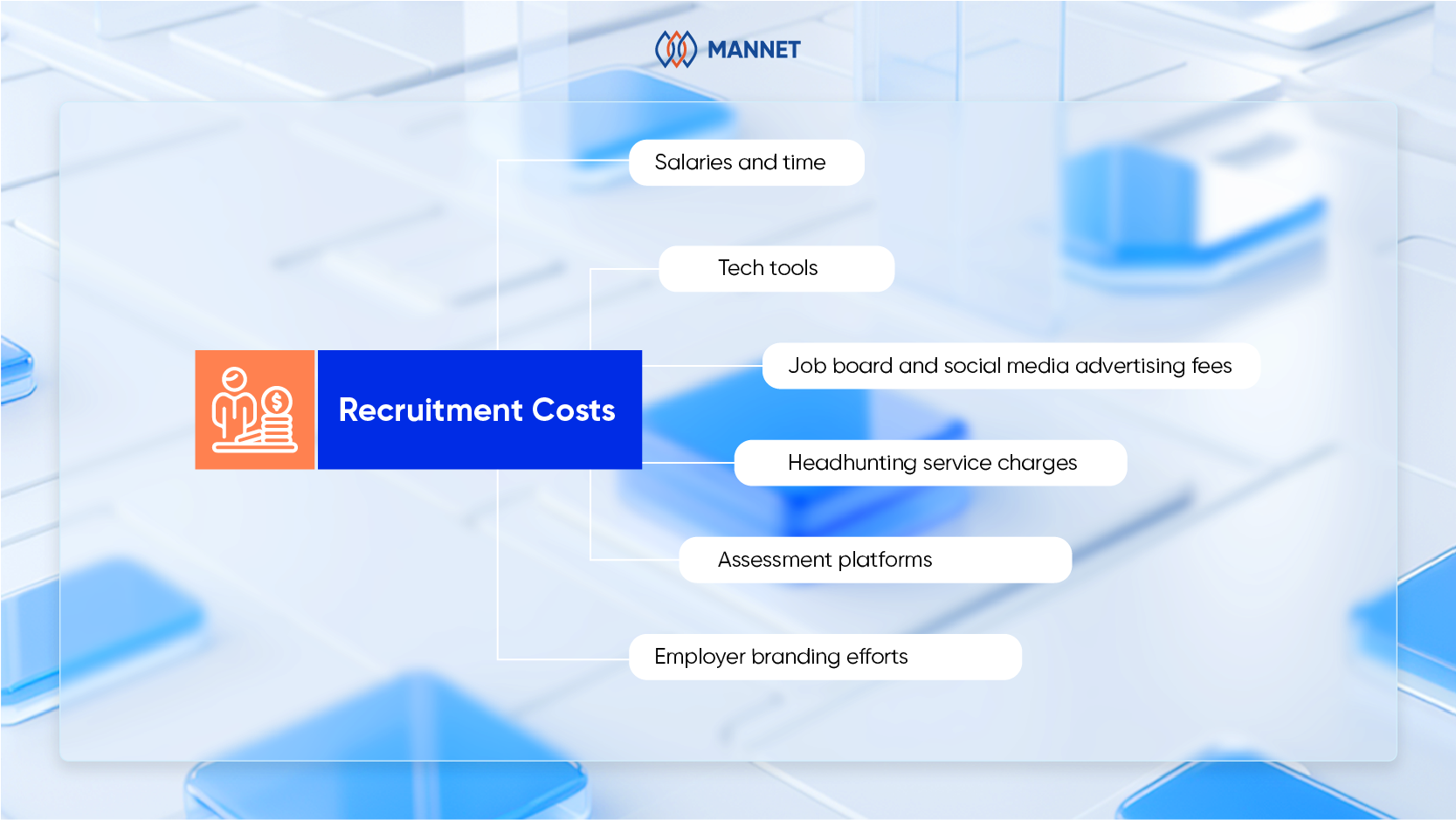
Recruitment costs components
Internal recruitment costs
These are costs generated within the company as part of day-to-day recruitment efforts. While they may not always appear as direct expenses, they still impact your overall budget. Typical internal costs include:
- Salaries and time of HR or recruitment staff
- Time spent by hiring managers screening CVs, conducting interviews, and coordinating with candidates
- Technology and tools, such as applicant tracking systems (ATS), internal referral platforms, or recruiting analytics software.
External recruitment costs
External recruitment costs refer to the money spent on third-party services or tools used to attract and evaluate candidates. These are often easier to track and may include:
- Job board and social media advertising fees
- Recruitment agency or headhunting service charges
- Assessment platforms, background checks, and other screening tools
- Employer branding efforts, such as content creation, recruitment events, or career page optimization.
To put total recruitment spending into perspective, one of the most useful metrics is cost per hire. It provides a clear benchmark for how much it costs, on average, to bring one new employee into the organization.
Cost per hire = (Internal recruitment costs + External recruitment costs) / Number of hires
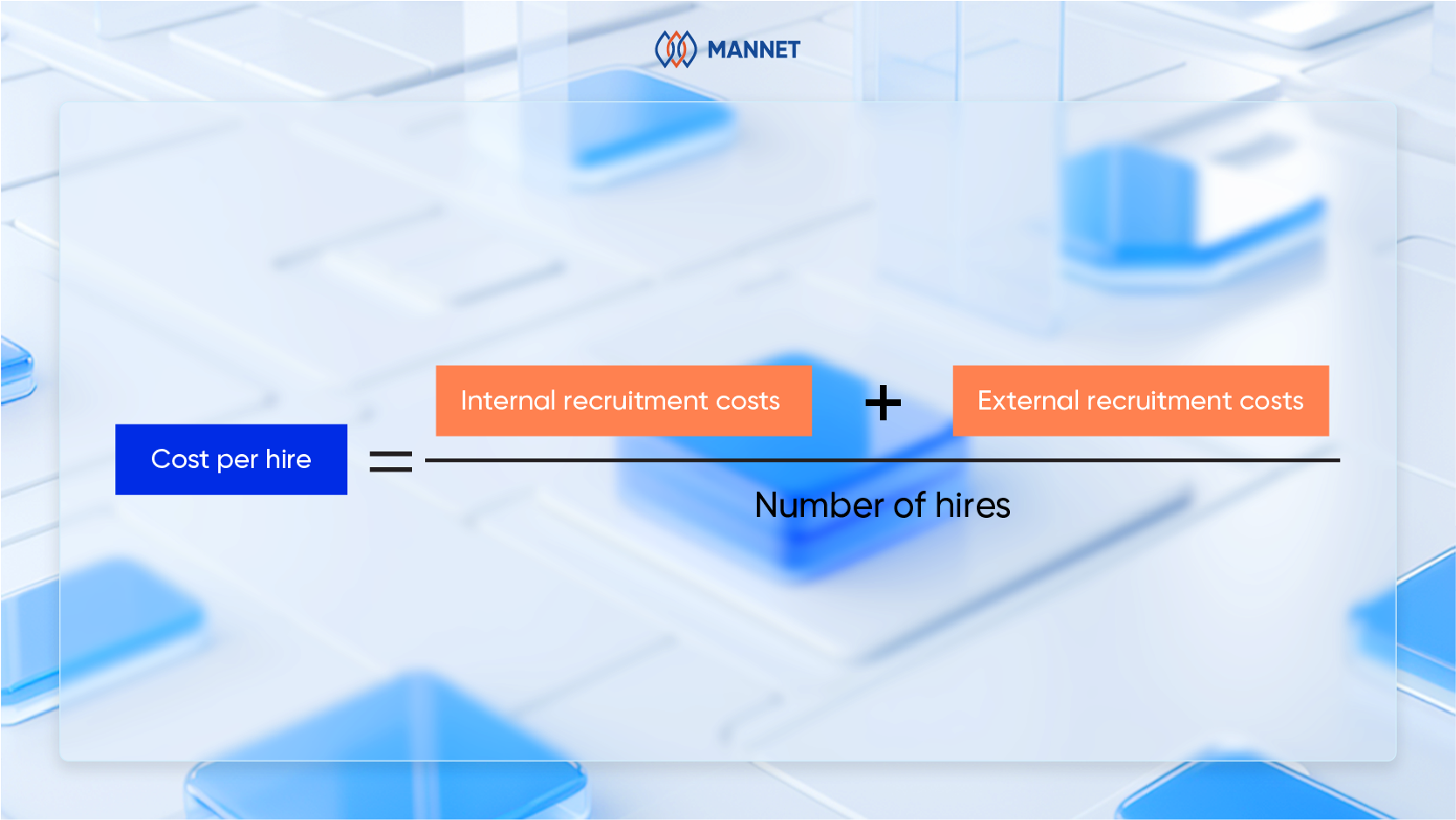
Cost per hire
For example, if your company spent $60,000 on total recruitment efforts over a quarter and hired 12 new employees, then the cost per hire = $60,000 ÷ 12 = $5,000 per hire.
How to Reduce Recruitment Costs at Every Stage
When recruitment costs spiral out of control, it’s usually because inefficiencies pile up at every stage of the process. The good news? Each stage offers concrete opportunities to reduce recruitment costs without compromising on quality.
Below is how to optimize the hiring funnel from first contact to final onboarding.
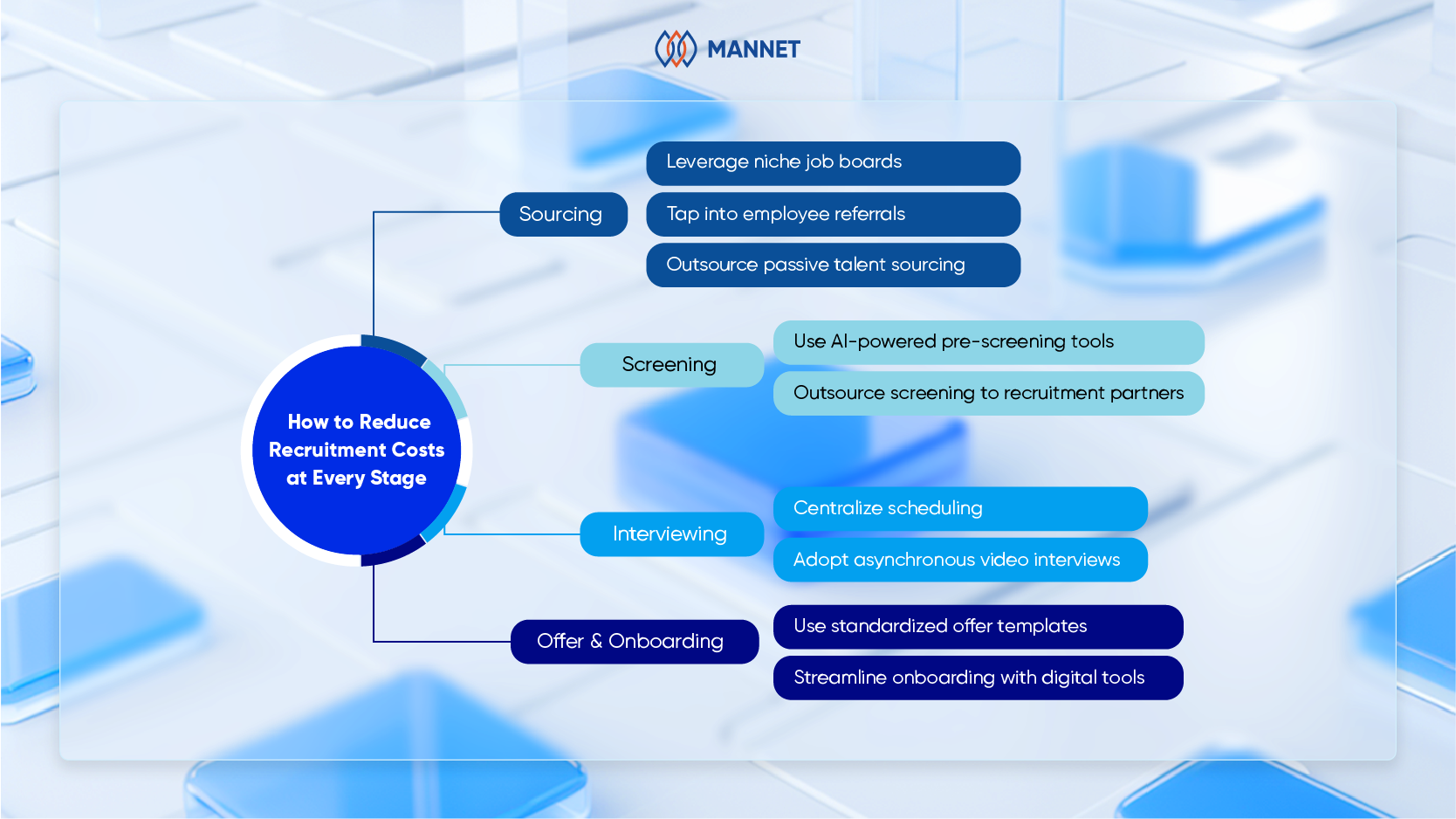
Reduce recruitment costs at every stage
Sourcing
Leverage niche job boards
One of the simplest ways to reduce recruitment costs is to stop casting too wide a net.
Instead of broad platforms that attract high volumes but low relevance, niche job boards tailored to specific industries or skill sets can help companies reach the right candidates faster and more cost-effectively.
When recruiting tech talent, businesses should consider platforms like Stack Overflow Jobs, GitHub, or regional tech communities.
The higher cost per posting often pays for itself through better candidate quality and faster fills. After all, when hiring for a senior developer role, receiving 50 highly relevant applications is far more valuable than sifting through 500 generic ones.
Tap into employee referrals
Data shows that 46% of referred hires stayed for at least one year after they were hired, as compared to 33% of people hired through career sites and 22% hired through job boards.

Employee referrals statistics
The best employees know other great people, so let’s take advantage of that network. Employee referrals consistently deliver faster hiring cycles and better retention rates, which dramatically helps to reduce recruitment costs in the long run.
To make the most of this strategy, businesses should implement a structured referral program with clear incentives.
Outsource passive talent sourcing
Here’s where many companies get stuck: they know passive candidates are often the best hires, but they don’t have the time or expertise to build those relationships effectively.
Partnering with specialized recruitment firms for passive sourcing can actually reduce recruitment costs significantly. Organizations pay for expertise and established networks, avoiding the months it takes to build relationships from scratch. The key is choosing a trusted recruiting partner who understands the business’s needs and can pre-qualify candidates before they ever reach the desk.
Screening
Use AI-powered pre-screening tools
AI screening tools can handle initial resume filtering and basic skill assessments, freeing the recruitment team to focus on promising candidates. These tools excel at identifying technical skills, experience levels, and basic requirements matches.
For optimal results, companies can combine AI screening with human review: where AI eliminates obvious mismatches and recruiters conduct deeper evaluations.
Outsource screening to recruitment partners
The benefits are clear: if an external partner can screen 20 candidates and present 3 strong fits, compared to an internal team reviewing all 20 manually, the time savings and efficiency gains quickly add up.
Look for partners who offer guarantees on their screening quality to make sure that they’re invested in getting it right the first time.
With the right partner, companies gain access to consistent evaluation standards and minimized risk of poor-fit candidates progressing.

Businesses can leveraging recruiting partners
That’s why many growing teams choose to work with providers like ManNet.
As a recruitment firm specializing in IT roles, ManNet brings together structured screening processes and deep industry insight to deliver candidates who truly fit. Instead of simply matching keywords on a CV, we take into account role requirements, team dynamics, and long-term fit, so internal teams only spend time with candidates who are truly aligned.
Interviewing
Centralize scheduling
Interview coordination may seem like a minor task, but it can quietly drain time and money if not handled efficiently. When candidates are bouncing between five different calendars, someone inevitably drops the ball, leading to rescheduling, candidate frustration, and extended time-to-hire.
To eliminate these inefficiencies, businesses can use scheduling tools like Calendly, which sync with team calendars. Even better, assign one person to coordinate all interviews for a role. This single point of contact reduces confusion and keeps the process moving smoothly.
Adopt asynchronous video interviews
For initial screening interviews, asynchronous video can be a game-changer. Candidates record responses to questions on their own time, and the HR team reviews them when convenient.
This works especially well for roles requiring communication skills or client interaction. Companies can evaluate presentation skills, thought processes, and cultural fit without coordinating schedules. Save synchronous interviews for finalists when businesses need real-time interaction and deeper technical discussions.
Offer & onboarding
Use standardized offer templates
Develop standardized templates for different role levels and types (e.g. contracts, salary letters and NDAs) with clear approval processes for any deviations.
This doesn’t mean inflexible offers but efficient ones. When a company can generate an offer letter in minutes rather than days, it reduces the risk of losing candidates to competitors and keep the hiring momentum strong.
Streamline onboarding with digital tools
Digital onboarding platforms simplify the entire process by centralizing paperwork, training modules, welcome messages, and progress tracking in one dashboard. New hires can hit the ground running without delays or confusion.
The first 30 days are crucial. When a company gives new employees clear expectations, regular check-ins, and structured learning paths from day one, they ramp up more quickly and are more likely to stay.
Key Challenges Businesses Face When Trying to Reduce Recruitment Costs
While it is a smart move to reduce recruitment costs for any organization aiming to improve efficiency, it often comes with trade-offs. Here are some of the most common challenges businesses encounter:
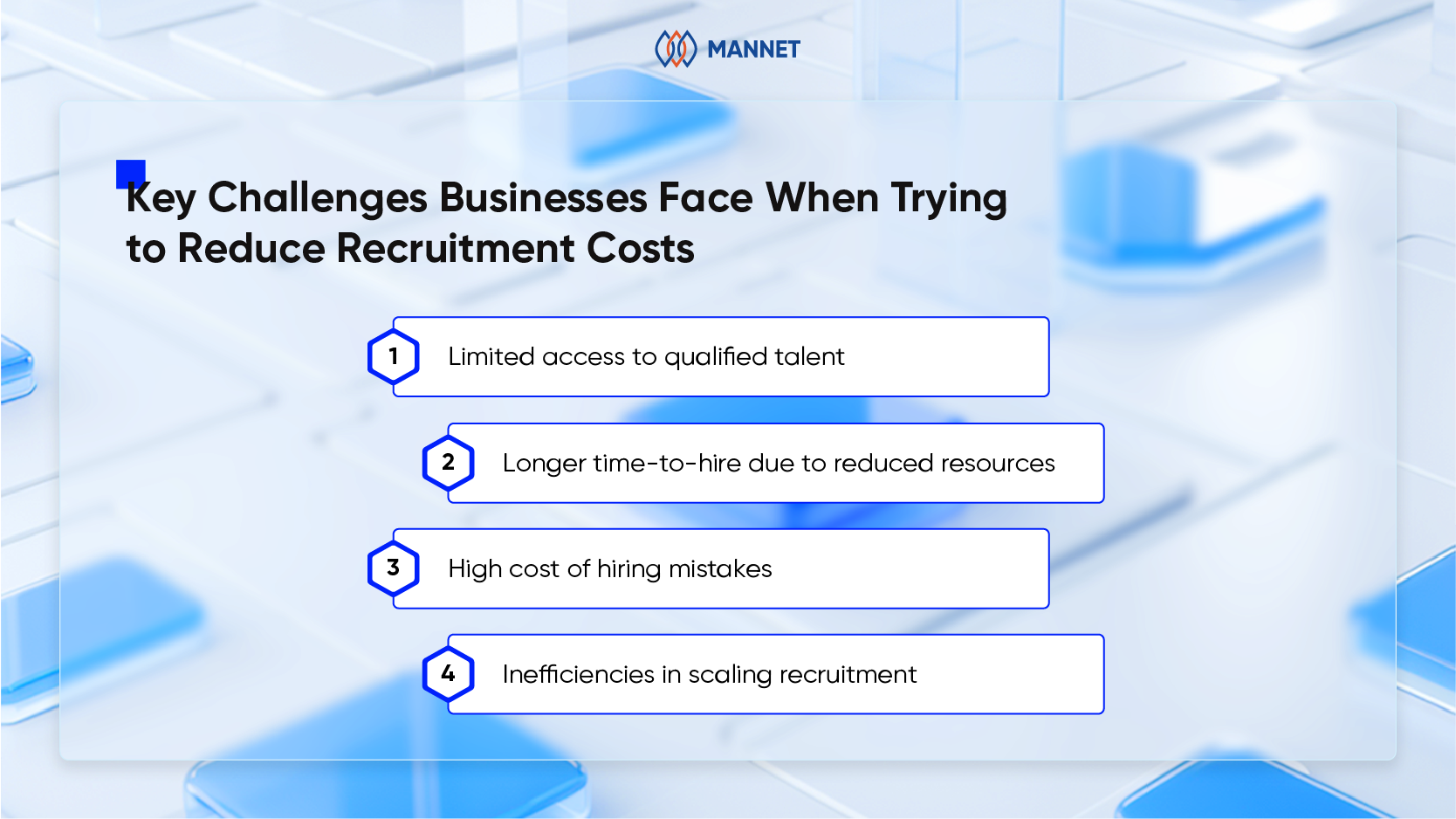
Reducing recruitment costs challenges
Limited access to qualified talent
To reduce recruitment costs, companies often cut down on on job advertisements, internal sourcing, or employer branding activities. However, this directly shrinks the visibility of open roles, narrowing the applicant pool and making it harder to attract high-quality candidates.
Fewer sourcing channels lead to longer search cycles and a compromised talent pipeline, forcing businesses to choose from a less competitive pool. Over time, this not only affects individual hiring decisions but also lowers the overall caliber of your workforce.
Longer time-to-hire due to reduced resources
A leaner recruitment budget often comes hand in hand with reduced internal capacity. When HR teams are downsized or stripped of the tools they need, the entire hiring process slows down. Screening, interviewing, and decision-making take longer, leading to extended vacancies and higher opportunity costs.
According to Workable, the global average time to fill for IT/technology roles sits around 30 days, and that figure increases significantly for specialized or senior positions.
High cost of hiring mistakes
The pressure to reduce recruitment costs can also result in organizations taking shortcuts, such as skipping key steps in vetting or onboarding, which increases the likelihood of bad hiring decisions.
And a poor hire can have far-reaching consequences. The U.S. Department of Labor estimates that a single bad hire can cost a company up to 30% of that employee’s first-year salary. In small to mid-sized companies, it often means losing tens of thousands of dollars per hire, not to mention the disruption it causes in team morale and productivity.
Inefficiencies in scaling recruitment
As businesses expand, their hiring needs often outpace the systems and processes they have in place. Without a scalable recruitment strategy or external support, internal teams struggle to manage higher volumes of roles, more complex requirements, and tighter deadlines.
This disjointed approach can damage the candidate experience, result in duplicated efforts across departments, and hinder long-term workforce planning. Over time, these inefficiencies can make it significantly harder for businesses to reduce recruitment costs while maintaining hiring quality.
How ManNet Helps Businesses Reduce Recruitment Costs
ManNet, as a specialized IT recruitment partner, has designed the process to cut recruitment expenses while improving results. Here’s exactly how we help businesses get more value from talent investments:
Access to pre-vetted talent pools
Rather than starting from scratch with each role, ManNet leverages actively maintained relationships with Vietnam’s top IT professionals across key domains.
When a business needs a senior React developer or DevOps engineer, we immediately tap into our existing network to deliver fast, qualified options.
ManNet organizes the talent pools by specialization: software development, AI & data, security, and more. This niche focus makes sure we’re finding the right developer for specific technology stacks and project requirements.
Competitive pricing
We believe recruitment costs should be predictable and competitive. Instead of paying for recruiter time, our clients pay for successful hires.
Compare this to the hidden costs of internal recruiting: recruiter salaries, tool subscriptions, job board fees, and the opportunity cost of the technical team’s time spent in interviews. Our clients often find that partnering with ManNet helps to reduce recruitment costs compared to maintaining internal recruiting capabilities while delivering significantly better results.
Full hiring cycle as a service
ManNet takes care of the entire hiring process: sourcing, screening, evaluation, interview coordination, offers, and onboarding. By streamlining every step, our full-cycle service helps reduce recruitment costs significantly. Companies get involved in final decision-making, but we handle all the operational complexity. This means your technical leads focus on building products, not reviewing resumes.
For technical roles, we validate skills against specific technology requirements. We back our full-cycle service with a 60-day satisfaction guarantee. We’re so confident in our process that we’ll replace any hire who doesn’t meet expectations within the first 2 months.
Fast & high-quality recruitment
Our efficient hiring process consistently delivers high-performing candidates within just 7 working days. As a result, businesses can reduce recruitment costs by minimizing delays and inefficiencies.
Let’s take one of our recent success stories, for example: A leading Japanese manufacturer of cash handling systems faced costly delays filling urgent IT roles. By partnering with ManNet, they filled all 5 critical positions in record time – cutting their time-to-hire by 40% compared to their internal process.
Scalable solutions for growing teams
As business grows, their hiring needs evolve, and we grow with you. ManNet offers flexible recruitment models that adapt to each stage that scale with your organization, helping you reduce recruitment costs while maintaining agility and quality:
- Full-cycle recruitment: End-to-end hiring support, from sourcing to onboarding.
- Staff augmentation: Immediate access to pre-screened talent for project-based needs.
- HR operations support: Complete hiring infrastructure for companies entering the Vietnamese market.
This flexibility means businesses are never paying for more than they need while having the option to expand services as requirements grow. Start with a single hire, scale to team-level augmentation, or build a long-term talent pipeline with us.
FAQs on Reducing Recruitment Costs
- How can working with a recruitment partner reduce hiring costs?
A recruitment partner brings specialized expertise, established talent networks, and efficient processes that shorten time-to-hire. By outsourcing, companies can reduce internal overhead, avoid the cost of mis-hires, and fill roles faster.
- What’s a good benchmark for recruiting costs?
Recruiting costs vary by company and role, but a useful approach is to set a clear budget based on your average cost per hire. Use tools like spreadsheets or ERP systems to track and control expenses. It’s best not to obsess over recruiting costs. If higher costs translate into better people for your team, your investment is worthwhile.
- Is outsourcing recruitment more expensive than doing it in-house?
Not always. While outsourcing may seem like an added upfront cost, it can be more cost-effective overall. In-house hiring involves hidden expenses – like recruiter salaries, job board fees, tools, and lost productivity from stretched internal teams. A trusted recruitment partner can streamline the process, reduce time-to-hire, and deliver better-fit candidates, helping you avoid costly mis-hires and delays.
Final Thoughts on Reducing Recruitment Costs
The key to sustainable cost reduction lies in optimizing each stage of the recruitment process while maintaining candidate quality. However, many businesses struggle to strike this balance, often lacking the specialized expertise for efficient IT recruitment or the resources for consistent, scalable processes.
ManNet’s tailored recruiting services are built to help companies reduce recruitment costs without sacrificing talent quality. We combine deep market knowledge, streamlined processes, and transparent pricing to deliver both cost savings and superior hiring outcomes.
Curious how these strategies could apply to your hiring challenges? Let’s start a conversation with ManNet now.



